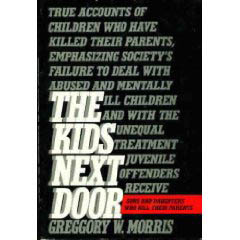This New York Times June 18 special project on homicides in New York City provides good resource material for aspiring journalists interested in writing about, well, murder and crime. And I will most likely try to incorporate into the reading list of one of my advanced news writing classes. Story and the multimedia can be found here. And that recommendation allows me, in good conscious, to segue to this recollection: That period in my journalistic life when murder was on my mind.
I became aware of it when I was the Day Police Reporter for the Democrat & Chronicle in Rochester, New York, where I got a good boot camp introduction to the criminal justice system and as a reporter that got me close to murder. That experience helped me to write my first book years later, The Kids Next Door: Sons and Daughters Who Killed Their Parents, published by William Morrow & Co.
It made money and got decent reviews.
It provided me an opportunity to debunk some myths of the Who, What, When, Where and Why of homicide and to throw a light on such matters as incompetent psychologists and psychiatrists and defense lawyers, poor police and trial news reporting and shortcomings in powerful social institutions. I helped one kid to have his matricide conviction thrown out and for him to be eventually released and for another to get a sentence reduction in a patricide conviction. For awhile, I was providing advice to defense attorneys with clients accused of patricide and matricide. The latter period ended when I was advised that I could get into trouble for allegedly providing legal advice without a license. That is, even though I wasn’t providing legal advice an angry DA could accuse me of engaging in an unlicensed activity and make me shell out bucks for a defense. I didn’t need the harassment.
Nevertheless, that experience led me to try to do the next book, tentatively titled Kids on Death Row, the research for that project, which never saw the light of day, took me to death rows in Florida, Tennessee and Oklahoma before I decided to do Unspeakable Acts: The Ordeal of Thomas Waters-Rimmer, whose mom died at the hands of her common law husband and whose death had been erroneously attributed by the Cuyahoga County Coroner’s Office to natural causes.
His mom’s death had not been planned as a major thematic focus of the books – the focus became getting at the truth of the rumors about child sexual abuse passed on from one generation to the next in his family – it became thematically important on the search for the truth.
Which, in my mind, allows this segue: The search for the truth, whether in my personal or professional lives, I’ve only recently come to understand how they are conjoined, is the sine qua non of my existence. Which helps explain one of my missions, i.e., getting to the bottom of the existence of phenomena like the 4 Barnacles of the Apocalypse.
Tags: crime reporting, Democrat & Chronicle, homicide, matricide, murder, New York City crime, New York City homicides, New York Times, patricide, pursuit of truth, The Kids Next Door
